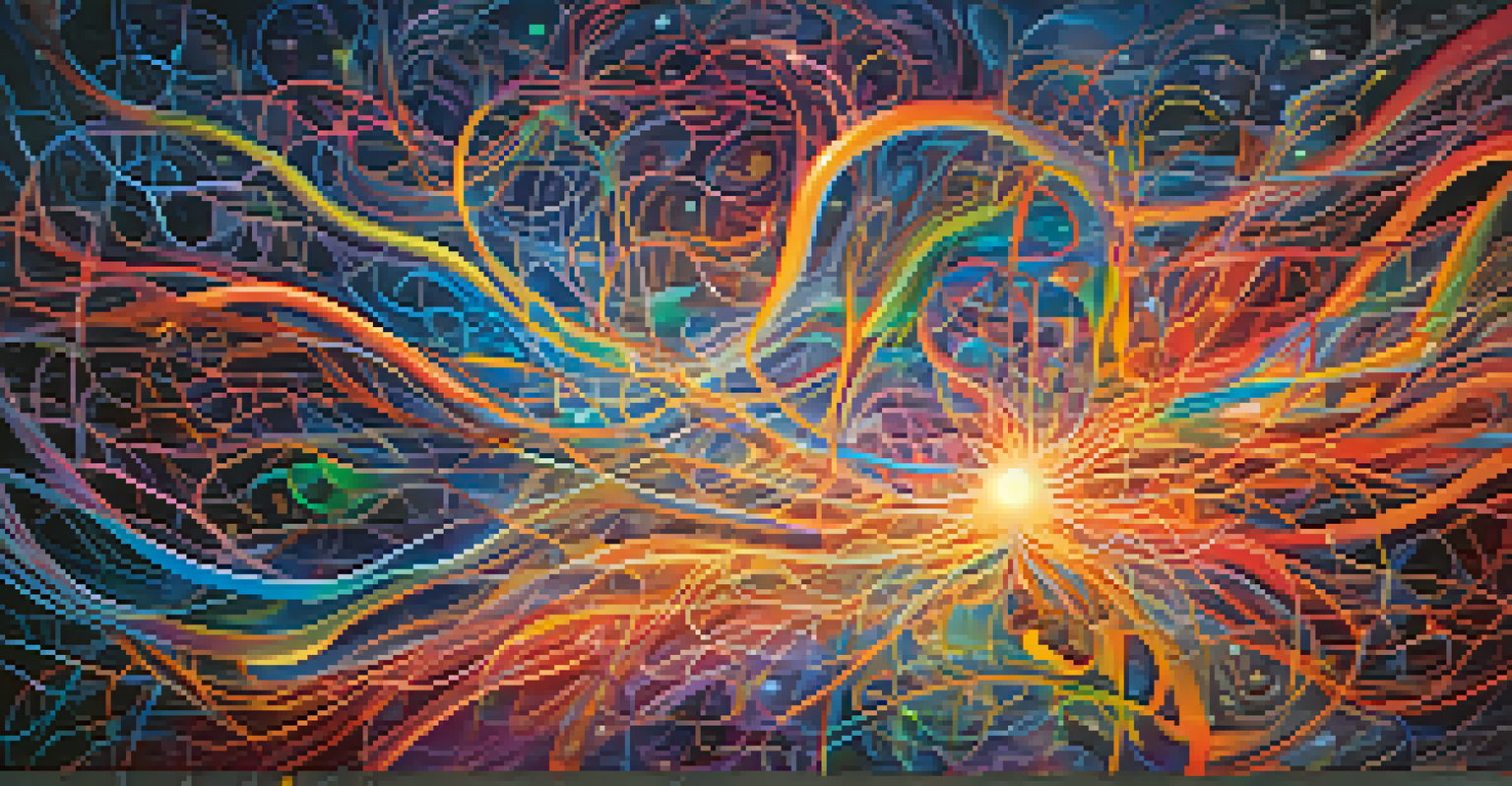Hallucinogens: A Pathway to Deeper Dream Exploration

Understanding Hallucinogens and Their Effects
Hallucinogens are substances that alter perception, mood, and cognitive processes. Common examples include LSD, psilocybin, and DMT, which are known for their profound effects on consciousness. While often associated with recreational use, these substances have a rich history in spiritual and therapeutic contexts.
The greatest value of a dream is not in what you see but in what you become when you wake up.
These compounds can lead to experiences that feel dream-like, where the boundaries of reality blur. Users often report enhanced visual and auditory sensations, leading to a unique perspective on their thoughts and emotions. This altered state can provide insights that might not be accessible in ordinary waking life.
As scientific research resumes on these substances, understanding their potential for personal growth and deeper introspection has gained traction. By examining the mind through the lens of hallucinogens, we can explore not only our realities but also the vivid landscapes of our dreams.
The Connection Between Hallucinogens and Dreams
Dreams are often seen as a reflection of our subconscious mind, and hallucinogens can amplify this connection. Both experiences share similarities, such as altered perceptions and emotional processing, making them intriguing to compare. When under the influence of hallucinogens, individuals may encounter dream-like scenarios that evoke the same feelings and symbols found in their sleep.

This overlap can lead to greater self-awareness and understanding of one’s inner thoughts. For instance, someone might confront repressed emotions or unresolved conflicts during a hallucinogenic experience, much like in a dream. This journey into the subconscious can serve as a powerful tool for personal transformation.
Hallucinogens Enhance Self-Discovery
These substances can lead to profound insights, helping individuals explore their subconscious and gain self-awareness.
Ultimately, exploring the parallels between hallucinogens and dreams opens the door to understanding ourselves on a deeper level. The insights gained can help us navigate our waking lives, making us more attuned to our thoughts, feelings, and desires.
Therapeutic Uses of Hallucinogens in Dream Work
In recent years, researchers have begun exploring the therapeutic potential of hallucinogens in treating various psychological conditions. Studies suggest that these substances can help individuals process trauma and anxiety, leading to more vivid and meaningful dreams. This therapeutic approach often involves guided sessions where patients can explore their emotions and experiences safely.
The mind is everything. What you think you become.
For instance, during a guided session with psilocybin, participants may confront fears or anxieties that resurface in their dreams. By addressing these issues in a heightened state of awareness, they can gain valuable insights and healing. The integration of these experiences can enhance the overall therapeutic process.
As we continue to uncover the benefits of hallucinogens in therapy, the potential for deeper dream exploration becomes increasingly evident. This intersection of science and spirituality can pave the way for innovative approaches to mental health and self-discovery.
Navigating the Hallucinogenic Experience Safely
While the allure of hallucinogens for dream exploration is compelling, safety and responsible use are paramount. It's essential to approach these substances with respect and caution, ideally in a controlled environment. Many practitioners advocate for guided experiences, where trained professionals can provide support and ensure a safe journey.
Preparation is key; setting intentions before a hallucinogenic experience can shape the outcome. Think of it like setting the stage for a play—what themes do you want to explore? This mindfulness can help direct the experience toward meaningful insights and avoid overwhelming or negative encounters.
Therapeutic Potential of Hallucinogens
Research shows that hallucinogens can aid in processing trauma and anxiety, enhancing both dream experiences and mental health.
Moreover, integrating the lessons learned from these experiences into daily life can enhance their impact. Journaling about the journey and reflecting on insights can bridge the gap between the hallucinogenic experience and everyday reality, enriching both dreams and waking life.
Cultural Perspectives on Hallucinogens and Dreams
Different cultures have long recognized the connection between hallucinogens and dreams, often incorporating them into spiritual practices. Indigenous tribes, for example, have used substances like peyote and ayahuasca in rituals aimed at connecting with the divine or seeking guidance through dreams. These practices highlight the deep-rooted belief in the power of altered states for personal and communal growth.
In many cultures, dreams are viewed as a bridge to the spiritual realm, and hallucinogens can enhance this connection. Participants often describe experiences of encountering ancestors or receiving messages from the universe, enriching their understanding of life’s mysteries. This cultural lens adds depth to the conversation about using hallucinogens for dream exploration.
Understanding these cultural perspectives can inform our own practices and beliefs about hallucinogens. By acknowledging the wisdom of those who came before us, we can approach our own journeys with humility and respect, ensuring that we honor the traditions and insights offered by diverse cultures.
The Science Behind Hallucinogens and Dream States
Recent studies have begun to unravel the neurological mechanisms at play during hallucinogenic experiences. Research shows that hallucinogens affect serotonin receptors in the brain, which play a crucial role in mood and perception. This alteration can lead to vivid visualizations and emotional experiences, similar to those encountered in dreams.
Neuroscientists have found that these substances can increase connectivity between different brain regions, leading to a more integrated experience of thoughts and feelings. This phenomenon may explain why individuals often report profound insights during hallucinogenic journeys, mirroring the often chaotic yet enlightening nature of dreams.
Cultural Insights on Hallucinogens
Many cultures view hallucinogens as tools for spiritual exploration, enriching our understanding of their role in personal growth.
As we continue to explore the science behind hallucinogens and their effects on the brain, we gain valuable insights into the nature of consciousness itself. This dual exploration of both dream states and hallucinogenic experiences may ultimately deepen our understanding of human psychology and the mysteries of our minds.
Integrating Insights from Hallucinogens into Daily Life
After a hallucinogenic experience, many individuals feel a strong urge to integrate their insights into everyday life. This process can be transformative, allowing personal growth and emotional healing. Journaling, meditation, and discussion with trusted friends or therapists can be effective ways to process these experiences and make sense of the lessons learned.
For example, someone might realize during a hallucinogenic journey that they need to address a long-standing fear. By taking actionable steps in their waking life, such as seeking therapy or confronting the issue directly, they can create meaningful change. This integration not only enhances personal development but can also enrich one’s dream life.

Ultimately, the journey doesn't end with the hallucinogenic experience. By remaining open to the lessons learned and actively applying them to our daily lives, we can foster a deeper connection to ourselves, our dreams, and the world around us.